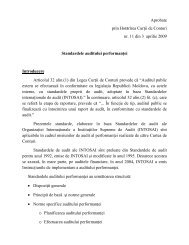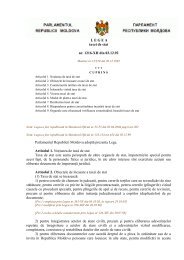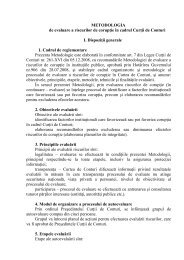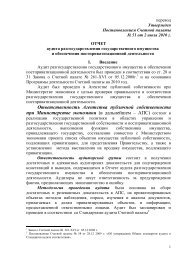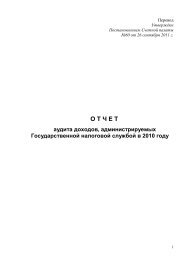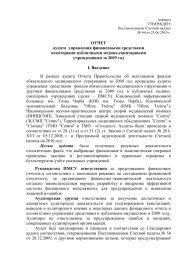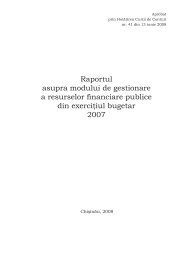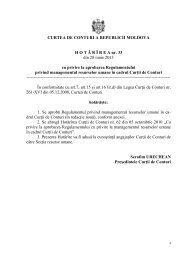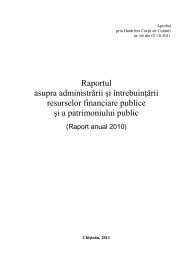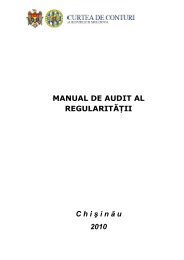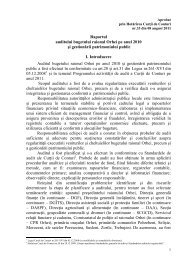Buletin 3_4-2010 web.pdf - Curtea de Conturi a Republicii Moldova
Buletin 3_4-2010 web.pdf - Curtea de Conturi a Republicii Moldova
Buletin 3_4-2010 web.pdf - Curtea de Conturi a Republicii Moldova
Create successful ePaper yourself
Turn your PDF publications into a flip-book with our unique Google optimized e-Paper software.
As a result of the Public Finance Management Project, started<br />
in 2006 and continued in the present, public entities should adjust<br />
their internal control systems to best practices and international standards<br />
.<br />
In this regard, the Ministry of Finance – the institution responsible<br />
for the second component of the Public Finance Management Project,<br />
has <strong>de</strong>veloped the legal framework for the implementation of<br />
internal control and audit, and recently, in September <strong>2010</strong>, the Parliament<br />
adopted the Law on public internal financial control, which<br />
will take effect in one year, after its publication in the Official Gazette,<br />
and will be a sound basis for managers of public entities to implement<br />
the internal control system in the institutions they manage .<br />
One of the elements of the internal control system is financial management<br />
and control (hereinafter – FMC), which inclu<strong>de</strong>s all activities<br />
and processes of the public entity . The implementation of FMC<br />
is accomplished according to national standards on internal control,<br />
and is based on the five elements of COSO mo<strong>de</strong>l .<br />
The primary responsibility for implementation of this system lies<br />
with the manager, who monitors how the operational managers control<br />
the processes and who in turn hold the employees responsible<br />
for the establishment of internal control policies that are more specific<br />
to their activity . Therefore, to a certain extent, each employee of<br />
the public entity contributes and is responsible for the implementation<br />
of FMC, having responsibilities and tasks set by the manager, and<br />
put in practice by employees .<br />
As a result of external audit missions performed by the Court of<br />
Accounts in <strong>2010</strong> in local and central public authorities, multiple <strong>de</strong>ficiencies,<br />
related to the accounting and financial discipline, were i<strong>de</strong>ntified<br />
. These <strong>de</strong>ficiencies occur primarily because the FMC system is<br />
not implemented, and adversely affect the management of public<br />
funds by entities .<br />
the main findings i<strong>de</strong>ntified by the Court of accounts’ teams<br />
are the following:<br />
1 . A large part of audited public entities do not set strategic objectives,<br />
which are the main goals an entity should achieve, in or<strong>de</strong>r<br />
to reach its overall goal . The objectives are usually set on medium or<br />
long term, and are <strong>de</strong>rived from the corresponding government policies<br />
. The same refers to the operational objectives, which should<br />
be normally set for a period of one year, and stand for the operational<br />
business goals nee<strong>de</strong>d for the achievement of strategic objectives .<br />
2 . Facing FMC implementation, auditees find themselves without<br />
the <strong>de</strong>scription and documentation of operational processes, which<br />
Internal Audit<br />
fInanCIal management and Control<br />
SyStem In publIC entItIeS<br />
Ana Radu,<br />
head of internal Audit Service<br />
47<br />
internal Audit



